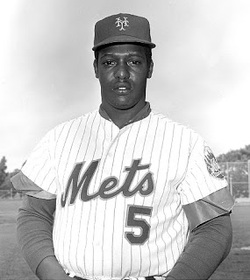
While Foy's time with the Mets would serve as a duplication of what would happen to Jim Fregosi when the Mets acquired him a couple years later, it really is hindsight to assume Foy would have dropped off in his one season with the Mets like he did. In hindsight, we know what became of Otis, and to a lesser extent; know that Johnson struck out 206 batters and pitched to a 3.07 ERA for the Royals in 1970 before winning a World Series with the Pittsburgh Pirates in 1971. Nobody expected Joe Foy to drop off like he did, unfortunately.
Foy was originally signed as an ameteur free agent by the Minnesota Twins in 1962, The Boston Red Sox took him in the minor league draft right after the 1962 season. He made his MLB debut in 1966 with the Red Sox, playing 151 games and hit .262, 15, 63 as Boston's everyday 3B. He remained the team's everyday 3B in 1967, playing in 6 of the 7 games in the 1967 World Series against the World Series Champion St Louis Cardinals. For the season, he hit .251, 16, 49 in 130 games, but was just 2-15 in the World Series.
He did fall off during the 1968 season, as he hit just .225, 10, 60 in 150 games for the Red Sox. He had some range at 3B and was respected as a good defensive player. But the Red Sox, concerned about his offensive production, left him unprotected for the 1968 expansion draft, giving the Kansas City Royals or Seattle Pilots the opportunity to select him if they wished. The Royals took Foy with the 4th overall pick in the AL expansion draft, with their second pick. Foy responded with a solid 1969 season; he tied his batting average of 1966 at .262, and hit 11 HR and a career high 72 RBI for the Royals playing 145 games. While he was the Royals everyday 3B, he also managed to play all positions for the exception of pitcher and catcher during that season.
No question the Royals sold high to get some return for Foy, as he was sent to the Mets in exchange for Otis and Johnson. Foy, of course, struggled for the Mets in 1970, hitting just .236, 6, 37 in 99 games. The Mets would leave Foy unprotected for the 1970-1971 Rule 5 draft. The Washington Senators selected Foy in the draft, leaving the Mets with nothing to account for the loss of Otis, who like I mentioned before, was already an All Star in his one season in Kansas City. Foy showed he had little left during the 1971 season, hitting just .234, 0, 11 in 41 games while spending some time in the minors. By July 16th, he was released by the Senators and his professional career was finished by the age of 28.
The fact that the Otis and Johnson for Foy trade was such a bust for the Mets is pretty easy to see based on the results. However, with proven outfielders Cleon Jones, Tommie Agee and Ron Swoboda just 27, 27 and 26 respectively, Otis probably did not have a clear path to play in the big leagues right away. It was not the fact that Otis was traded that set the Mets back, it was the fact that he probably could have netted the Mets a better return for his services.
The bigger issue with Foy was the fact that he simply did not fit in with his new teammates. Born in New York City, he quickly reconnected with his old friends after the Mets traded for him. After several incidents where he allegedly under the influence of an unknown drug, later reported confirmed as marijuana, it was evident the trade was a mistake. Perhaps he sold himself short because of his substance dependence. Stories are still told of his actions including a double header where he walked in front of the Mets dugout in the middle of a pitch and cheered in front of manager Gil Hodges. He was unable to see a ball hit passed him and supposedly was still waiting for the ball to be pitched. It was clear at that point that Foy would not be returning to the Mets in 1971. Perhaps the only reason he remained on the Mets roster for the entire 1970 season was the fact that Otis was an All Star and Johnson was closing in on his 200+ strikeouts. He probably should have been released as he was a distraction to a team that had higher exectations. Sadly, Joe Foy passed away on October 12, 1989 of a heart attack on what was my 10th birthday.

 RSS Feed
RSS Feed
